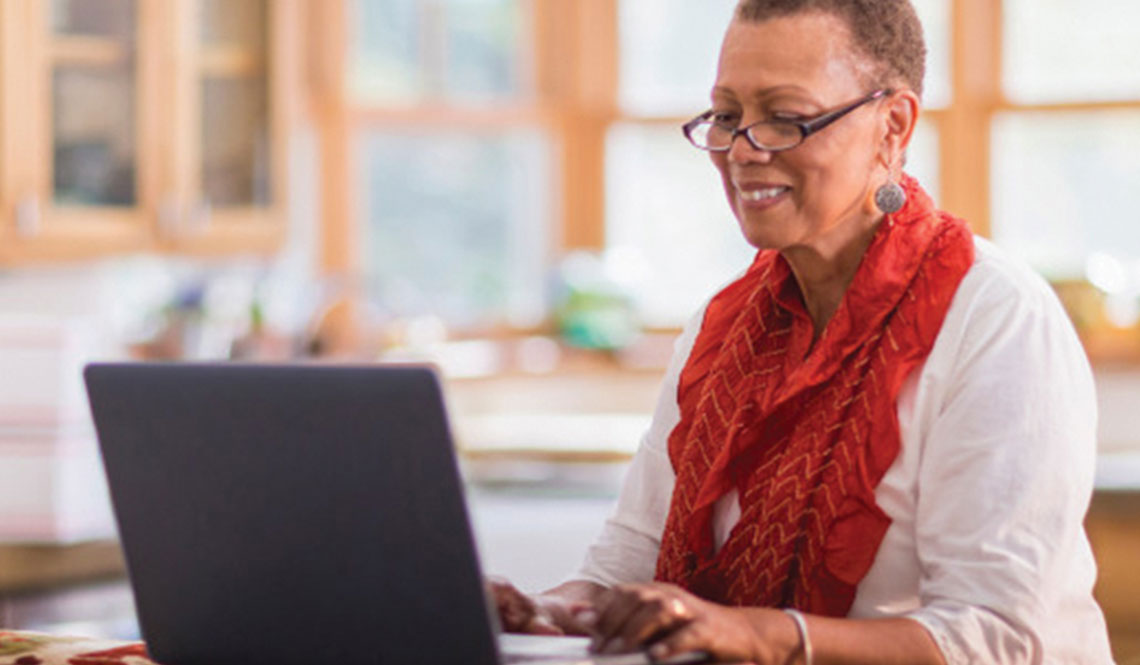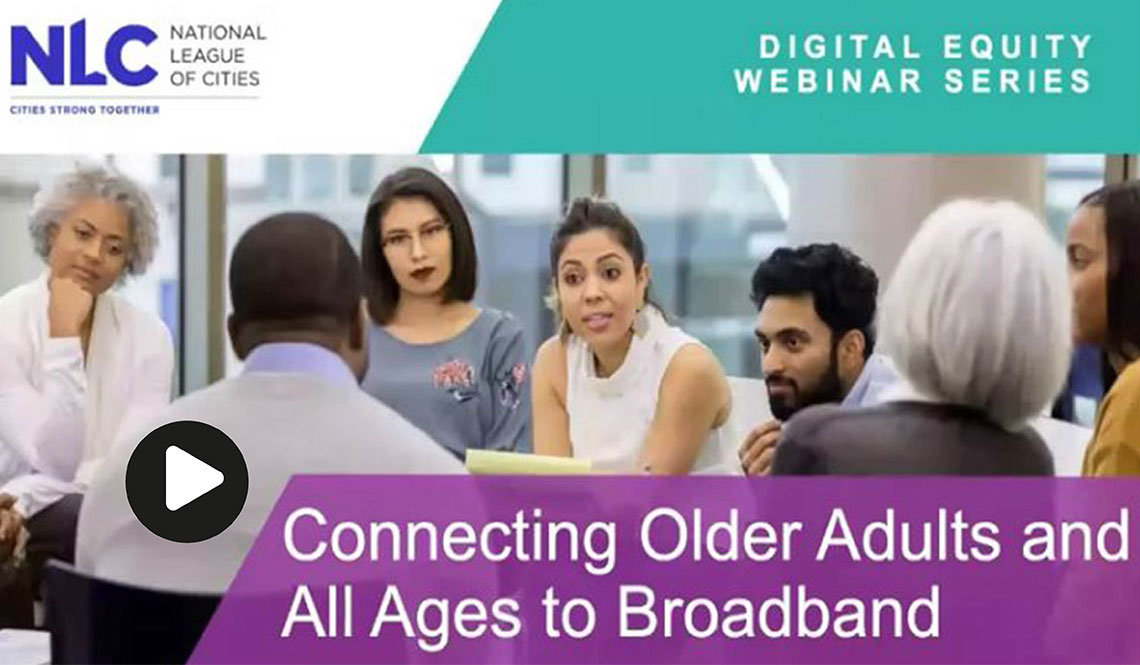Video: Connecting Older Adults to Broadband
Watch a recording of a webinar featuring the chair of the Federal Communications Commission, leadership from AARP and the National League of Cities, and more
"No matter who you are, where you live, or where you came from — or how young you are, how young at heart you are or how old you are — we've got to figure out as a nation how to get all of our households online. Doing so is necessary for full participation in modern life."
— Jessica Rosenworcel, chair, Federal Communications Commission
Access to high-speed internet service — also called broadband — can help older adults maintain their independence and security, receive improved medical care, socialize and connect with family caregivers, and maintain their productivity in the workforce.
Click here or on the image above to watch the webinar video.
Featured Speakers
Vince Williams (moderator)
Mayor, Union City, Georgia, and President, National League of Cities
Vivian Brady-Phillips
Executive Director, Jersey City Housing Authority
Nancy LeaMond
Executive Vice President, Chief Advocacy and Engagement Officer, AARP
Jessica Rosenworcel
Chair, Federal Communications Commission
On May 24, 2022, AARP joined Jessica Rosenworcel, chair of the Federal Communications Commission (FCC), and leaders from the National League of Cities (NLC) and Jersey City Housing Authority (see box) for a live webinar discussion about the importance of high-speed internet access for older adults, the barriers they face in accessing and adopting broadband use — and the strategies local leaders can use to get residents of all ages connected.
The discussion, an offering of NLC’s Digital Equity 2022 Webinar Series, was moderated by Vince Williams, the mayor of Union City, Georgia, and president of the NLC.
"Older adults face additional hurdles in affording and using broadband," he noted in his opening remarks. "But they also stand to gain a great deal from getting connected. Broadband access and connected devices can help residents age in place." Topics and highlights from the conversation follow.
Internet access is a necessity
“An absolutely critical lesson of the pandemic was that access to high-speed internet, along with tech devices and the skills to use them, is an absolute necessity. It is not a luxury,” said Nancy LeaMond, AARP Executive Vice President, Chief Advocacy and Engagement Officer.
According to Older Adults Technology Services, an AARP affiliate commonly referred to as OATS, approximately 40 percent of older adults were not able to access needed online services — such as telehealth visits or ordering groceries — from their homes during the pandemic. Given that older adults were and are the most at risk for death or serious illness from COVID, leaving their homes for services and shopping further exposed them to the virus. Exacerbating the public health and internet inaccessibility crisis, at the beginning of the vaccine distribution, immunization appointments were only available by registering online.
Too many older adults are on the other side of the digital divide
The discussion noted three key factors for the fissure between older Americans who do and don’t have broadband access.
- Geography: Entire communities, particularly in rural areas but even in urban centers, aren’t wired for high-speed internet. Most of these communities are populated by lower-income residents and older adults.
- Price: According to an AARP survey, 60 percent of adults age 50 or older say the high cost of broadband access is a problem for them.
- Training: Although many older people are experienced technology users, others simply lack the skills needed to take advantage of computers, smartphones and the internet.
Added to the price and training parts of the puzzle is, of course, the necessity of actually owning or having access to a computer or mobile device.
Panelist Vivian Brady-Phillips is the executive director of the Jersey City Housing Authority, which serves low-income to moderate-income residents. A 2018 assessment of residents' internet and technology access found, she says, that they were underserved.
"We're looking at access to devices. We're looking at internet connectivity and we're also looking at education," she said. "We really want our seniors, and all of our residents, to have the ability to not just get online, but to really be able to explore and do all of the things we now know are essential online from health care to accessing information."
Brady-Phillips noted that a grant from AARP helped her agency procure Wi-Fi enabled tablets and smart speaker devices for more than 100 older adults. The Affordable Connectivity Program (learn more below) and other programs have helped her launch a wide-ranging "digital inclusion" program. By the end of 2022, free, high-speed internet will be available in all New Jersey Housing Authority residences.
Narrowing the divide
The Affordable Connectivity Program (ACP), provides subsidies to help improve access to high-speed internet. A part of the bipartisan infrastructure bill that President Biden signed into law in November 2021, the ACP allows eligible recipients to receive a discount of up to $30 per month for high-speed internet services. Additionally, nearly two-dozen internet service providers are offering broadband access for no more than $30 a month to U.S. households that are eligible for the ACP, making the program essentially free to those individuals.
As the FCC’s Rosenworcel explained: “It’s the nation’s largest-ever broadband affordability project and it is designed to help low-income households get online and stay online,” she said. “It is designed to provide that recurring monthly support, so you don't have to make hard choices about [choosing among] gas and groceries and keeping online.”
Enrollment in the ACP was at 12.7 million households as of early July 2022. Four in 10 of those enrollments are Americans over age 50. Despite the success, there’s still a long way to go.
“We've got to figure out, as a nation, how to get all of our households online,” said Rosenworcel, adding that the FCC is also looking at “digital discrimination” issues in order to understand which communities have been overlooked and underserved and what policy changes are needed so “nobody is left behind.”
Spreading the word about getting connected
The webinar panel shared strategies for how to reach older adults at the local level. “When people hear about this program from people they trust in their community, they're more likely to sign up,” Rosenworcel explained.
Other outreach methods for spreading the word about the ACP and broadband access needs:
- Contact mayors and other “on the ground” leaders.
- Engage with a state’s broadband office (about three-dozen states have one) or broadband advisory council.
- Reach out to every community partner — government entities, nonprofits, schools, area agencies on aging, houses of worship — and ask that they join the effort and identify shared resources. (Partnering with faith-based communities in Detroit helped boost ACP enrollment by, as noted during the webinar, an estimated 25 percent.)
- Find the “real” community centers, such as ethnic grocery stores. “There are trusted actors in every community,” LeaMond points out. “Figure out how to convene them.”
- Spread the word by phone and multilingual printed materials in order to meet people without broadband where they are, which is not online.
- Go to where people without home internet access go — such as libraries, coffee shops and even fast food parking lots — for their broadband connections.
More about Broadband, Older Adults and Equity
The following organizations have resources that can be used by local leaders, advocates and residents.
From the National League of Cities:
From the Federal Communications Commission:
From the Institute for Local Self-Reliance:
From AARP Livable Communities
Page published August 2022 | Reporting by Amy Lennard Goehner
AARP.org/Livable
Find articles, publications and more




